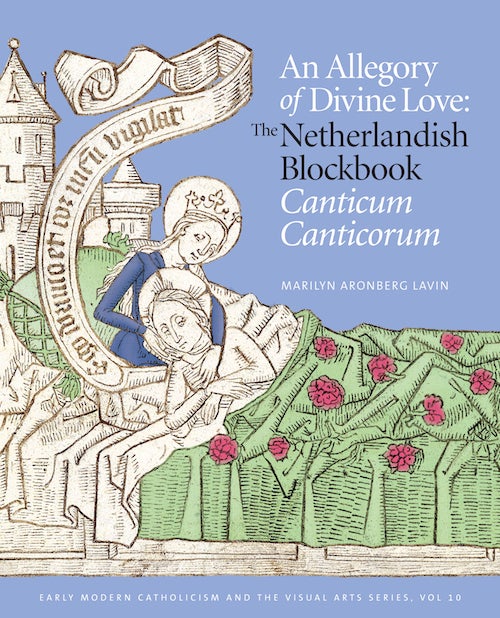
An Allegory of Divine Love:; The Netherlandish Blockbook "Canticum Canticorum"
Price: $85.00
Place Published: Philadelphia
Publisher: Saint Joseph's University Press
Date Published: 2014
ISBN: 9780916101794
Book ID: 73
Description:
Early Modern Catholicism and the Visual Arts, Vol. 10
viii + 238 pages / index / 9 1/2 x 11 1/2 in. / 207 color images
The Netherlandish Canticum Canticorum is a late 15th-century blockbook ordinarily bound with larger, more impressive, and better known blockbooks, particularly the Biblia Pauperum and the Speculum Humanae Salvationis. An Allegory of Divine Love offers the first art-historical analysis of the Canticum Canticorum, Latin for Song of Songs, as an independent work of art of the highest caliber: rather than the end of a long Gothic tradition, it is revealed as a major work of Early Renaissance art, full of beautiful compositions, original ideas, and an intellectual challenge to a devoted, reading public. This blockbook is composed of eight large sheets of paper, stacked and gathered in the center to form sixteen folios, printed by hand rubbing on one side only; there are four rectangular woodcut compositions involving haloed figures, landscapes and interiors, on each opening, with thirty-two scenes in all.
As a blockbook, the Canticum's most salient feature is the fact that it has no printed identification. The sheets bear no page-signatures or rubrics. The framed scenes contain no titles. There is no commentary of any kind. The title page contains the words Canticum Canticorum, but nothing more. In the rest of the book, verbal matter consists solely of Latin inscriptions that appear in elaborately scrolling banderoles often as large as the figures. The verses quoted without identification seemingly have been chosen at random since, in the sequence, they do not follow the order of the biblical poem. But in fact, the characteristic of "order in disarray" relates to the literary form known as the cento, a sophisticated literary mode handed down from antiquity in which disparate passages from a venerable text are ingeniously selected and arranged to form a new work. All these elements distinguish the Canticum from other contemporary blockbooks.
The author discusses each of the thirty-two framed scenes individually, as visual images within the larger framework of the history of art, as poetic dialogues composed of hallowed lines newly ordered to create a new poem, and as theological allusions in the form of human interaction. The result, in apperceiving the thirty-two scenes as a unified whole, is new narrative the plot of which becomes clear. It is suggested that contemporary readers were expected to do the same using observation, study, contemplation and devotion. And what they found is the story of the Virgin Mary's preparation for her divine role, as a model of action for every good soul in her/his "marriage with Christ."
Marilyn Aronberg Lavin is a senior scholar in the field of Italian art history, who lives and works in Princeton, N.J. She has been visiting professor of art history at Princeton, Yale, and the University of Maryland. The author of several books on Piero della Francesca, she has also been a pioneer in the use of computers (database research and three-dimensional walk-through reconstructions) for the history of art. Her book, Seventeenth-Century Barberini Documents and Inventories of Art (New York University Press, 1975), won the Charles Rufus Morey Award from the College Art Association.
CRITICAL ACCLAIM
"This welcome book by Marilyn Aronberg Lavin helps to illuminate a work of underappreciated complexity: a blockbook of the Canticum Canticorum. . . . Lavin's study is at once disciplined in organization and exploratory in content."
Andrea Pearson (American University), Sixteenth Century Journal
"The Canticum Canticorum blockbook, which Marilyn Aronberg Lavin's beautifully illustrated monograph aims at presenting to a wider audience, is a cycle of thirty-two woodcut images based on the Song of Songs and arranged in sets of four, intended to be assembled as a book of sixteen leaves. . . . The method of exposition used by Lavin is to assemble parallels for each of the mysterious scenes from medieval and Renaissance art in order to reconstruct the associations a contemporary audience might have used to decode the picture, after which she rehearses interpretations of the Bible verses from biblical scholarship . . . , followed by her own summary analysis. . . . The exploration of [a variety] of possibilities of [interpretation] . . . has been made possible for the first time . . . in this study, with a wealth of imaginatively chosen visual comparanda that, when taken all together, gives [the blockbook] a significant place in medieval art, whether for women or men, for monks, nuns, or lay people."
Nigel F. Palmer (Oxford University), Renaissance Quarterly



